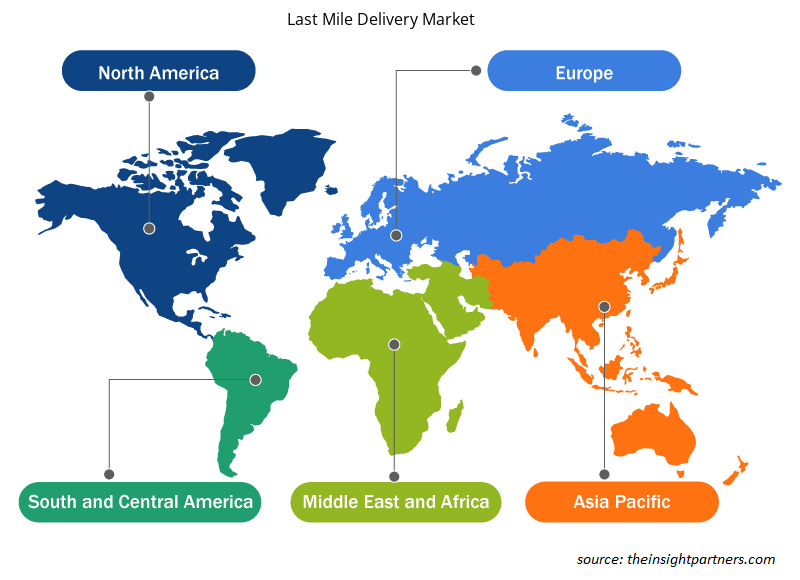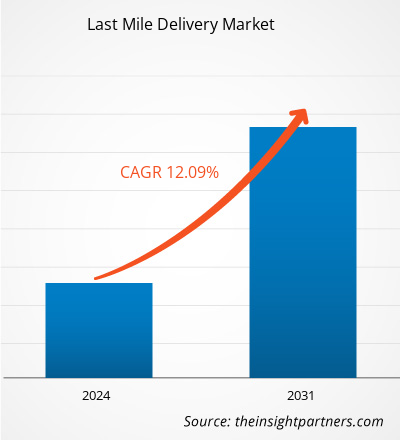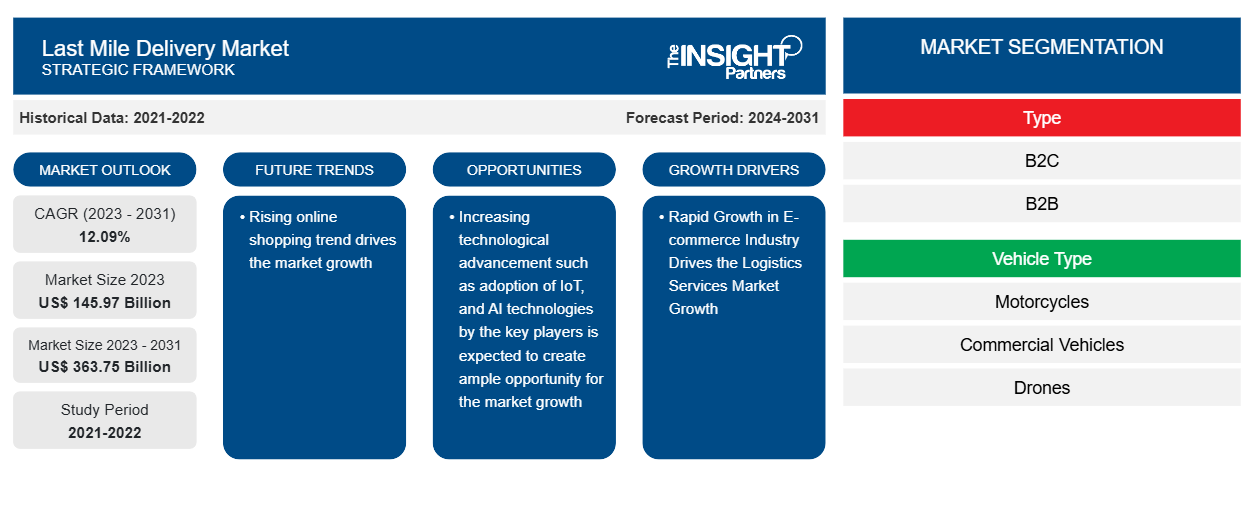最后一英里配送市场规模预计将从 2023 年的 1459.7 亿美元增至 2031 年的 3637.5 亿美元。预计 2023-2031 年市场复合 年增长率为 12.09%。最后一英里配送是配送过程的最后一步,在此过程中,产品从运输/仓储中心转移到最终目的地,通常是个人住宅或商业网点。这是配送过程中最重要的阶段,因为消费者的整体购物体验和品牌忠诚度都取决于它。推动全球最后一英里配送市场发展的主要因素之一是电子商务行业在全球范围内的渗透率不断提高。全球网上购物在印度、墨西哥、巴西和阿根廷等发展中国家迅速增长。
最后一英里配送市场分析
最后一英里配送供应商在全球范围内运送了超过 250 亿个包裹。最后一英里配送主要由第三方物流供应商通过公路和航空运输完成。最后一英里配送是将包裹送达最终客户的最终配送过程。最后一英里配送包括从仓库到客户家门口,这被称为最后一英里配送。最后一英里配送是一种昂贵且耗时的运输过程,但总体客户满意度是主要公司的主要标准。
最后一英里配送市场概览
然后,物流公司介入并使用现代软件根据位置、交通和送货时段等标准规划送货路线。为了应对各种大都市环境,货物使用从基本卡车到尖端无人机和电动汽车等各种车辆快速运输。关键的“最后一英里”阶段涵盖了交付的最后一段,产品直接交付给客户,这通常得益于实时跟踪技术,以实现透明度和便利性。
最后一英里配送市场由各种利益相关者、技术集成、物流基础设施和不断发展的消费者行为组成。主要利益相关者是电子商务巨头和零售商,然后物流公司也参与其中。这些组织从提供路线优化配送管理等工具的技术公司那里获得帮助。除了软件公司外,许多无人机制造商和服务提供商也参与其中。
定制此报告以满足您的需求
您可以免费定制任何报告,包括本报告的部分内容、国家级分析、Excel 数据包,以及为初创企业和大学提供优惠和折扣
-
获取此报告的关键市场趋势。这个免费样品将包括数据分析,从市场趋势到估计和预测。
最后一英里配送市场的驱动因素和机遇
电子商务行业增长推动最后一英里配送市场增长
电子商务行业主要依靠最后一英里配送来管理包裹配送到最终客户。全球对在线购物的需求增加,以及全球互联网普及率的激增,是预测期内最后一英里配送市场增长的主要驱动因素。预计未来几年在线购物者的数量将会增加。这一增长直接影响了产生的收入。2019 年,美国电子商务总销售额达到 5955 亿美元,比 2018 年的 5185 亿美元增长 14.9%。这也是美国电子商务七年来增长最快的速度之一,仅次于 2017 年 15.5% 的同比增长
无人配送系统的日益普及以及物流公司对先进技术的快速采用预计将为市场增长创造充足的机会。
未来,美国企业计划部署数百万辆无人驾驶送货车来运送包裹,以满足日益增长的电子商务行业需求。此外,零售商、商家、餐馆、酒店和杂货店对按需电子商务领域使用的紧凑型送货车和车辆的需求也在增加。这些汽车(例如全尺寸乘用车)旨在满足日益增长的最后一英里交付需求。此外,市场上的几家主要参与者正在开发和推出基于先进技术的解决方案,以满足客户对包裹或货物交付的需求。例如,2023 年 9 月,麦格纳国际开发并推出了自动驾驶最后一英里交付解决方案。新解决方案面向北美各大都市推出。
此外,2022 年 3 月,麦格纳还开发了机器人,用于在美国底特律地区运送披萨业务。麦格纳一直在不断发展,以改善最后一英里的送货服务业务。预计市场主要参与者发起的此类举措将在预测期内为全球最后一英里送货市场创造充足的机会。
最后一英里配送市场报告细分分析
有助于得出最后一英里交付市场分析的关键部分是类型、平台、应用程序和最终用户。
- 根据类型,市场分为B2C和B2B。
- 根据车辆类型,市场分为摩托车、商用车、无人机、自动地面车辆和其他。
- 根据最终用户,市场细分为杂货、家庭必需品/家庭用品和家居装饰、餐厅餐饮、服装和服饰、消费电子产品、玩具/爱好/体育用品、大众商家、珠宝、专业商品、汽车零部件和配件等。
最后一英里配送市场份额(按地区)分析
最后一英里交付市场报告的地理范围主要分为五个地区:北美、欧洲、亚太、中东和非洲、南美。
北美最后一英里配送市场预计将在亚太地区占据最大份额,并在预测期内以最高的复合年增长率增长。北美市场受在线购物快速增长的推动,电子商务行业的激增推动了全球最后一英里配送市场的增长。在美国,截至 2023 年,有超过 2.747 亿人在网上购物。在美国,约 81% 的美国总人口通过在线电子商务网站购物。截至 2023 年,美国电子商务行业总收入达到 11,370 亿美元。北美国家在线购物的如此快速增长为最后一英里配送市场创造了巨大的增长。
最后一英里配送市场区域洞察
Insight Partners 的分析师已详细解释了预测期内影响最后一英里配送市场的区域趋势和因素。本节还讨论了北美、欧洲、亚太地区、中东和非洲以及南美和中美洲的最后一英里配送市场细分和地理位置。

- 获取最后一英里配送市场的区域特定数据
最后一英里配送市场报告范围
| 报告属性 | 细节 |
|---|---|
| 2023 年的市场规模 | 1459.7亿美元 |
| 2031 年市场规模 | 3637.5亿美元 |
| 全球复合年增长率(2023 - 2031) | 12.09% |
| 史料 | 2021-2022 |
| 预测期 | 2024-2031 |
| 涵盖的领域 |
按类型
|
| 覆盖地区和国家 |
北美
|
| 市场领导者和主要公司简介 |
|
最后一英里配送市场参与者密度:了解其对业务动态的影响
最后一英里配送市场正在快速增长,这得益于终端用户需求的不断增长,而这些需求又源于消费者偏好的不断变化、技术进步以及对产品优势的认识不断提高等因素。随着需求的增加,企业正在扩大其产品范围,进行创新以满足消费者的需求,并利用新兴趋势,从而进一步推动市场增长。
市场参与者密度是指在特定市场或行业内运营的企业或公司的分布情况。它表明在给定市场空间中,相对于其规模或总市场价值,有多少竞争对手(市场参与者)存在。
在最后一英里配送市场运营的主要公司有:
- 罗宾逊
- 德铁信克物流
- 联合包裹服务公司
- 日本通运
- 基华物流
- DSV 空运和海运
免责声明:上面列出的公司没有按照任何特定顺序排列。

- 获取最后一英里交付市场顶级关键参与者的概览
最后一英里配送市场新闻和最新发展
通过收集一手和二手研究后的定性和定量数据来评估最后一英里交付市场,其中包括重要的公司出版物、协会数据和数据库。以下是最后一英里交付市场的发展和战略列表:
- 2023 年 11 月,亚马逊公司在印度启动了最后一英里配送车队计划,该计划使用电动汽车为其配送服务提供商提供服务。根据该计划,该公司推出并采用了 Mahindra Zor Grand 的三轮电动车来提供亚马逊的最后一英里配送服务。(来源:DJI,新闻稿/公司网站/时事通讯)
- 2023 年 10 月,配送管理平台提供商 Bringg 推出了 ROAD 模块化平台,以优化和动态管理内部车队并实现最后一英里配送自动化,为司机、调度员和客户创造无缝体验。(来源:Flyability,新闻稿/公司网站/时事通讯)
最后一英里配送市场报告覆盖范围和交付成果
“最后一英里交付市场规模和预测(2021-2031)”报告对市场进行了详细分析,涵盖以下领域:
- 范围内涵盖的所有主要细分市场的全球、区域和国家层面的市场规模和预测
- 市场动态,如驱动因素、限制因素和关键机遇
- 未来的主要趋势
- 详细的PEST分析
- 全球和区域市场分析涵盖关键市场趋势、主要参与者、法规和最新市场发展
- 行业格局和竞争分析,涵盖市场集中度、热点图分析、知名参与者和最新发展
- 带有 SWOT 分析的详细公司简介
- 历史分析(2 年)、基准年、预测(7 年)及复合年增长率
- PEST和SWOT分析
- 市场规模、价值/数量 - 全球、区域、国家
- 行业和竞争格局
- Excel 数据集
近期报告
客户评价
购买理由
- 明智的决策
- 了解市场动态
- 竞争分析
- 客户洞察
- 市场预测
- 风险规避
- 战略规划
- 投资论证
- 识别新兴市场
- 优化营销策略
- 提升运营效率
- 顺应监管趋势























 获取免费样品 - 最后一英里配送市场
获取免费样品 - 最后一英里配送市场